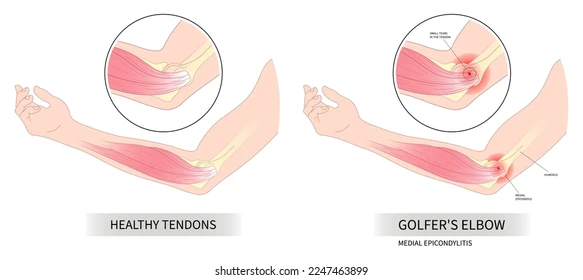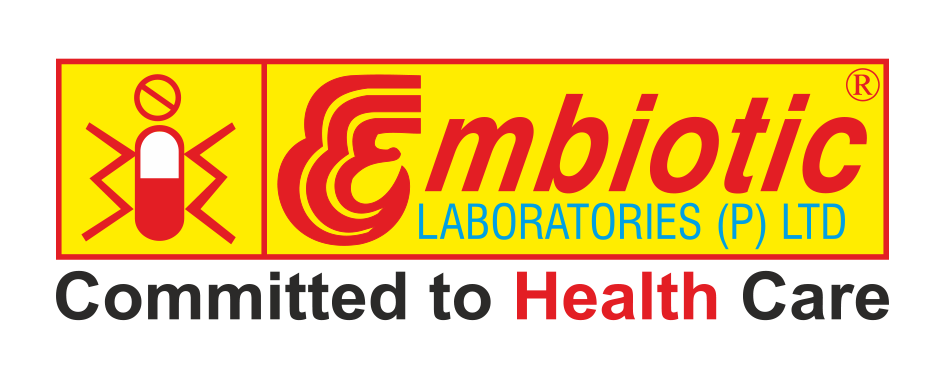June 2, 2025
That nagging pain on the inside of your elbow – the kind that flares up when you try to grip something, twist your wrist, or even make a simple fist? If this sounds familiar, you might be experiencing golfer’s elbow, a common yet often misunderstood condition that extends far beyond the golf course.
This blog delves deep into the intricacies of golfer’s elbow, exploring its causes, symptoms, diagnosis, and, most importantly, the various strategies for finding relief and getting back to your pain-free life.
Unravelling the Anatomy: What Exactly is Golfer’s Elbow?
To truly understand golfer’s elbow, we need to take a quick look at the anatomy of your elbow joint. The bony bumps on the inside and outside of your elbow are called epicondyles. Golfer’s elbow specifically targets the medial epicondyle, the bony protrusion on the inner side of your elbow.

Several tendons attach to this medial epicondyle, primarily those responsible for flexing your wrist (bending it downwards towards your palm) and pronating your forearm (turning your palm downwards). When these tendons are subjected to excessive stress, overuse, or repetitive strain, microscopic tears can develop within them. This leads to inflammation, pain, and the constellation of symptoms we recognize as golfer’s elbow.

Beyond the Swing: Unmasking the Culprits
While the repetitive swinging motion in golf is a well-known contributor, a multitude of other activities can also trigger golfer’s elbow. These include:
- Other Sports: Baseball pitching, weightlifting, rowing, and certain racquet sports can trigger golfer’s elbow.
- Occupational Hazards: Many professions involve repetitive hand and wrist movements that can strain the medial epicondyle tendons. Examples includes: Construction workers, Carpenters, Assembly line workers, Computer users, Chefs and cooks
- Household Chores: activities like gardening, painting, and scrubbing can contribute if performed repetitively and with improper technique.
Deciphering the Signals: Recognizing the Symptoms
The hallmark symptom of golfer’s elbow is pain and tenderness on the inside of your elbow. However, other common symptoms include:
- Pain with specific movements: The pain often worsens when you flex your wrist against resistance, pronate your forearm against resistance, or grip objects firmly.
- Weakness in the hand and wrist: a weakened grip strength, making it difficult to hold onto things.
- Stiffness in the elbow: Especially in the morning or after periods of inactivity.
- Numbness or tingling: Pain and inflammation can irritate the ulnar nerve near the medial epicondyle, causing numbness or tingling in the ring and little fingers.
Navigating the Diagnosis: Seeking Professional Guidance
If you suspect you have golfer’s elbow, seeking professional medical advice is crucial for accurate diagnosis and appropriate management by an orthopaedic specialist or a sports medicine physician. Diagnoses is based on:
- Medical History: They will ask about your symptoms, activities, and any potential contributing factors.
- Physical Examination: This involves a series of specific tests to assess the tenderness around the medial epicondyle and evaluate pain and weakness during wrist flexion and forearm pronation.
- Imaging Studies: In most cases, imaging studies like X-rays, MRIs and Ultrasound are not needed to diagnose golfer’s elbow. However, they might be ordered to rule out other conditions, such as arthritis or fractures, if the diagnosis is unclear or if there are unusual symptoms.
The Path to Recovery: Treatment Strategies
The good news is that most cases of golfer’s elbow respond well to conservative treatment. Surgery is rarely necessary (only if it extends a threshold of severity). Common treatment strategies include:
- Rest and Activity Modification: Avoiding or significantly reducing the activities that aggravate your symptoms is essential to allow the tendons to heal.
- Ice Therapy: Applying ice packs to the affected area for 15-20 minutes several times a day can help reduce pain and inflammation.
- Pain Medication: Over-the-counter pain relievers like ibuprofen or naproxen (NSAIDs) can help manage pain and inflammation.
- Bracing: Wearing an elbow strap or counterforce brace just below the elbow can help reduce strain on the medial epicondyle tendons by altering the forces transmitted through the forearm muscles.
- Physical Therapy: A physical therapist can design a tailored exercise program to Reduce pain and inflammation, improve range of motion, Strengthen the forearm muscles, improve grip strength and educate on proper technique and ergonomics.
- Corticosteroid Injections: Injections of corticosteroids into the area around the medial epicondyle can provide short-term pain relief by reducing inflammation. However, repeated injections can also have potential side effects.
- Platelet-Rich Plasma (PRP) Injections: This involves injecting a concentrated solution of your own platelets into the injured tendon. Platelets contain growth factors that may promote healing.
- Dry Needling: This technique involves inserting thin needles into trigger points in the forearm muscles, which can help release tension and reduce pain.
Preventing Recurrence: Building Resilience
Once you’ve recovered from golfer’s elbow, taking steps to prevent it from returning is crucial:

- Proper Warm-up and Stretching: Before engaging in activities that could strain your elbow, make sure to warm up your forearm muscles with gentle stretches.
- Using Proper Technique: Whether you’re playing sports, working, or doing chores, focus on using correct form to minimize stress on your elbow. Consider seeking guidance from a coach, trainer, or physical therapist.
- Gradual Progression: Avoid sudden increases in the intensity or duration of your activities. Gradually build up your tolerance.
- Strengthening Exercises: Continue performing the strengthening exercises recommended by your physical therapist to maintain good muscle balance and support around your elbow.
- Taking Breaks: During repetitive activities, take frequent breaks to rest your forearm muscles.
- Ergonomics: Ensure your workspace is ergonomically sound, especially if you spend long hours typing. Keep your wrists in a neutral position.
- Listen to Your Body: Pay attention to any early signs of pain or discomfort and address them promptly. Don’t push through pain.
Living Well Beyond the Elbow Pain
Golfer’s elbow can be a frustrating and debilitating condition, impacting your ability to participate in activities you enjoy and even affecting your daily tasks. However, with a thorough understanding of the condition, accurate diagnosis, and a commitment to appropriate treatment and preventative measures, you can effectively manage your symptoms, regain full function, and return to a pain-free and active life.
Remember to seek professional guidance and be patient with the healing process. Your elbow will thank you for it.
Disclaimer: The information presented is accurate and evidence-based, drawing from reputable sources and adhering to ethical guidelines. This information is for general knowledge and informational purposes only and does not constitute medical advice.


